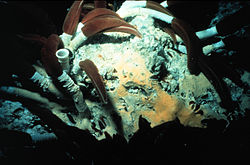Riftia
| Giant tube worm | |
|---|---|

| |
| Scientific classification | |
| Kingdom: | |
| Phylum: | |
| Class: | |
| Order: | |
| Family: | |
| Genus: | Riftia
|
| Species: | R. pachyptila
|
| Binomial name | |
| Riftia pachyptila M. L. Jones, 1981
| |
Giant tube worms, Riftia pachyptila, are marine invertebrates in the phylum Annelida[1] (formerly grouped in phylum Pogonophora and Vestimentifera) related to tubeworms commonly found in the intertidal and pelagic zones. Riftia pachyptila lives over a mile deep on the floor of the Pacific Ocean near black smokers and can tolerate extremely high temperatures and sulfur levels. They can reach a length of 2.4 m (8 ft).
They have a highly vascularized, red "plume" at the tip of their free end which is an organ for exchanging compounds with the environment (e.g., H2S, CO2, O2, etc). The tube worm does not have many predators, if any, for few creatures live on the sea bottom at such depths, but if threatened, the plume may be retracted into the worm's protective tube. The plume provides essential nutrients to bacteria living inside a specialized organ within their body (i.e., trophosome) as part of a symbiotic relationship. They are remarkable in that they have no digestive tract, but the bacteria (which may make up half of a worm's body weight) turn oxygen, hydrogen sulfide, carbon dioxide, etc. into organic molecules on which their host worms feed. This process was first recognized by Colleen Cavanaugh while she was a graduate student at Harvard.[2] This evolutionary adaptation presumably came about due to the fact that the worms live so far away from sunlight. With sun not available as a form of energy, the tubeworms rely on bacteria in their habitat to obtain nutrients.

The bright red color of the plume structures results from several extraordinarily complex hemoglobins found in them, which contain 24 or 144 globin chains (presumably each including associated heme structures). These tube worm hemoglobins are remarkable for being able to carry oxygen in the presence of sulfide, and indeed do also carry sulfide, without being completely "poisoned" or inhibited by this molecule, as hemoglobins in most other species are.
References
- ^ Ruppert, E., Fox, R., & Barnes, R. (2007). Invertebrate Zoology: A functional Evolutionary Approach. 7th Edition. Belmont:Thomson Learning. ISBN 0-03-025982-7
- ^ Cavanaugh, Colleen M. (1981-07-17). "Prokaryotic Cells in the Hydrothermal Vent Tube Worm Riftia pachyptila Jones: Possible Chemoautotrophic Symbionts". Science. 213 (4505): 340–342. doi:10.1126/science.213.4505.340.
{{cite journal}}: Check date values in:|date=(help); External link in|last=|coauthors=ignored (|author=suggested) (help)
See also
External links
- PMID 8621529
- PMID 15265029.
- http://www.seasky.org/monsters/sea7a1g.html
- http://www.ucmp.berkeley.edu/annelida/pogonophora.html
- http://www.ocean.udel.edu/deepsea/level-2/creature/tube.html
